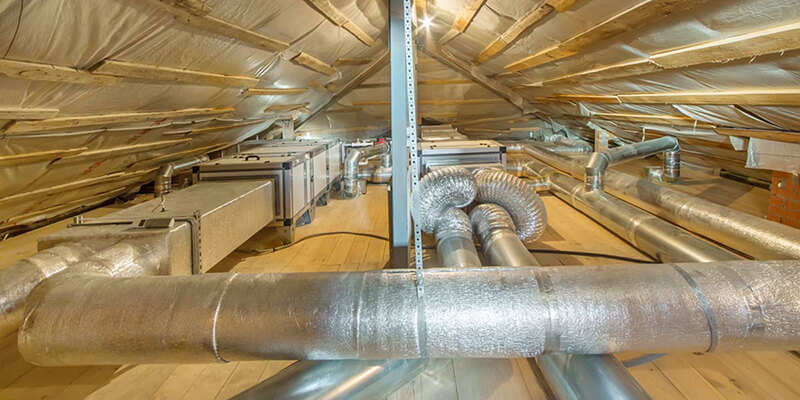Understanding the correct sizing for your return air ducts is pivotal for maintaining an efficient HVAC system in Houston. This detailed guide explores the essentials of return air duct sizing, featuring a practical sizing chart to help you ensure your system operates at its best. By optimizing duct sizing, you enhance not only the efficiency but also the overall comfort and air quality of your home.
What is a Return Air Duct?
Return air ducts are crucial pathways in your home’s HVAC system. They serve the fundamental role of cycling air back to the system for conditioning—whether that involves heating, cooling, or filtering—before redistributing it throughout your home. Proper sizing of these ducts is paramount to achieving maximum system efficiency and home comfort.
The Critical Role of Proper Duct Sizing
A. Efficiency and Energy Consumption:
The size of your return air ducts has a direct impact on the HVAC system’s efficiency. Incorrectly sized ducts—whether oversized or undersized—can lead to significant energy waste, diminished comfort, and inflated utility bills.
B. Impact on Air Quality:
Duct sizing also affects the air quality in your home. Inadequate sizing can restrict airflow, reduce system effectiveness in purifying air, and lead to an accumulation of pollutants, all of which compromise the health and comfort of your living environment.
How to Use the Sizing Chart Effectively
Utilizing the return air duct sizing chart involves calculating the necessary CFM for each room in your home. This calculation should account for various factors including the size of the space, the number of room occupants, and specific room characteristics such as the presence of high ceilings or large windows.
Step-by-Step Guide to Calculating Duct Size
- Determine Room CFM Requirements: Calculate the CFM needs by considering the volume of the space and the type of activity typically performed in the space.
- Match CFM with Duct Size: Using the CFM calculated, refer to the sizing chart to find the corresponding duct size that will effectively handle the airflow.
- Adjust for Unique Room Characteristics: Make adjustments based on specific room features or appliances that might affect airflow, such as kitchen ranges or bathroom vents.
Best Practices for Duct Sizing
Adhering to a few best practices can ensure your ductwork is optimally configured for your home:
- Accurate Load Calculation: Always begin with a precise load calculation to avoid inefficiencies.
- Consider Ductwork Layout: The layout of your ductwork should facilitate smooth and unrestricted air flow.
- Regular Maintenance: Schedule regular maintenance to ensure ducts remain free from leaks and blockages that could impair their performance.
Common Mistakes to Avoid in Duct Sizing
Avoid these frequent errors to save on repairs and ensure efficient system performance:
- Neglecting Proper Measurements: Ensure all measurements are precise to avoid mismatched duct sizing.
- Ignoring Leak Tests: Regularly test for duct leakage, which can significantly impact system efficiency.
- Overlooking Register and Grille Impact: The placement and size of registers and grilles can affect airflow dynamics and should be considered during the sizing process.
Conclusion:
Proper sizing of your return air ducts is crucial for ensuring your HVAC system operates efficiently, providing comfortable and clean air throughout your Houston home. Utilize our return air duct sizing chart to verify that your system is correctly designed to meet your specific needs. For more detailed information and professional HVAC services, trust Reliable Air Duct Cleaning Houston.
Don’t let improperly sized air ducts compromise your comfort and air quality. Contact Reliable Air Duct Cleaning today for expert advice and top-notch HVAC services. Call us now to schedule an appointment and ensure your system is running at peak performance!
FAQs:
1.Why is return air duct size important for HVAC efficiency?
Proper sizing of return air ducts ensures optimal airflow, which is critical for maintaining the efficiency of your HVAC system, reducing energy costs, and enhancing indoor air quality.
2. How can I tell if my return air ducts are the right size?
To determine if your return air ducts are appropriately sized, compare the system’s CFM requirements with our return air duct sizing chart, taking into account the specifics of your home’s layout and usage.
3. What are the consequences of incorrectly sized return air ducts?
Incorrectly sized ducts can cause your HVAC system to work inefficiently, leading to increased energy consumption, higher utility bills, and uneven heating or cooling.
4. What should I do if my return air ducts are not properly sized?
If your ducts are not properly sized, consulting with a professional HVAC technician to assess and modify your ductwork configuration is advisable.
5. How often should return air duct sizing be evaluated?
Return air duct sizing should be reviewed during regular HVAC maintenance checks, particularly if there have been changes to your home or system that could affect airflow.
6. Can return air duct size affect indoor air quality?
Yes, the size of your return air ducts directly impacts air quality by influencing how effectively your HVAC system circulates and filters air throughout your home.


